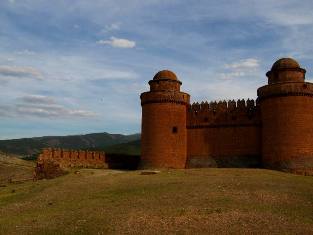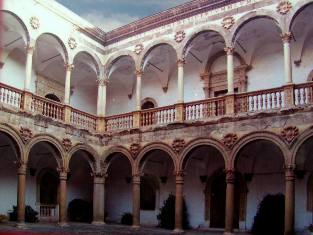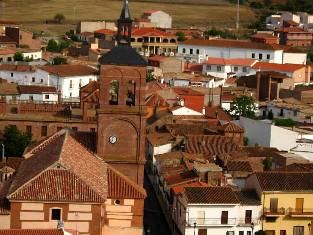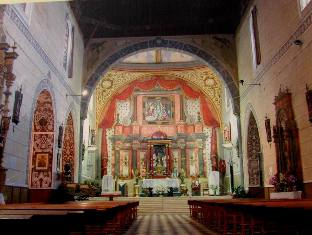
Travel to La Calahorra village
From Guadix and Purullena we went to the fascinating Castle of the Calahorra. The village of La Calahorra is situated just a few miles to the east by road in direction of Almeria. The castle can be visited on Wednesday 10am-1pm, 4pm-6pm.If you want to stay in La Calahorra, there are several accommodation options.
La Calahorra became the place of residence of the Marquises and therefore became the capital of El Marquesado after the Christian conquest, at the end of 1489, and the cration of the feudal state of El Cenete. This fact originated a certain "monumentalization" of the town where, besides the magnificent Renaissance castle-palace, numerous small palaces and noble residences would be built. Apart from these noble buildings, La Calahorra holds Our Lady of La Anunciacion Parish Church that is one of the biggest and most interesting Mudejar temples of El Marquesado.
 La Calahorra Castle
La Calahorra Castle
La Calahorra Castle-Palace is one of the most important Works of the firs Spanish Renaissance. It was constructed on the remains of a preceding fortification of the Medieval period dating from the beginning of the 16th century, probably between 1509 and 1512, and two arhitects mainly participated in the construction, the Castilian Lorenzo Vazquez and the Italian Michelle Carlone.
The castle is a singular building not only for its aspect and location, which make it the most characteristic element in the landscape of El Marquesado, but also for the originality of its conception and execution. Two different constructive and stylistic trends coincide on it, the Castilian defensive architecture and the purest Renaissance. The result is a fortress on the outside aspect and an exquisite and intimate palace on the inside, constructed using basically the stoen (limestone and for the balustrade and higher colonnade of the yaard, marble of Carrara) besides the brick and the mortar for some floorings and wallings up and the wood spledidly carved for the covering of the noblest living rooms.
 Inside of Calahorra palace
Inside of Calahorra palace
The central yard organizes the design of the inner space. This yard is what we can consider the Renaissance work of the construction. Ti is surrounded by a double gallery with arches that support the coat of arms of Los Mendoza and Los Foseca. The palace living rooms are designed round it, accessing to the room of arms and the body of arms in the lower part. Throgh a monumental marble stairs you get the high floor, where the Oratory, whose door is located in the Fine Arts Museum of Seville, the rooms of Arms and Justice and the private lodgings are located, all of them with yard and in its constructive elements (columns and arches, main fronts, windows, etc) where the Renaissance decorative program spreads, that is attributed to Michelle Calrone and that a series of vegetable elements and allegoric figures covering fiezes, lintels, pollars and pilasters, capitals and rose windows, and etc, are the protagonists.
The caracass that protects and hides this interior is a fortification in the Catilian style and with impregnable aspect. A huge box is added to the central chequered body that overtangs to its South side and that lodges the inner stairs, and in the corners cylindrical towers crowned by cupolas. One single entrace, some small embrasures and a few windows are the only gaps that break the ssolidity of the fortress. Rofrigo de Mendoza y Maria de Fonseca lived just eight years in the castle, which passed to the hands of the Marquises daughters.
 The War of the Moorishes (1568-71) which was especially violetn in El Marquesado of El Cenete, brought back the leadership of the castle, where the old Christians of the area look refuge and almost at the end of the war the Marquis of Mondejar and the Marquis of Javara withdrawed to barracks under the orders of Mr. Juan of Austria. Afterards the castle was practically abandoned for centuries. At the beginning of the 20th century, almost sold and moved stone by stone to ehe EEUU, it was purchased by the Duke of El Infantado and the Mrquis of Santillana.
The War of the Moorishes (1568-71) which was especially violetn in El Marquesado of El Cenete, brought back the leadership of the castle, where the old Christians of the area look refuge and almost at the end of the war the Marquis of Mondejar and the Marquis of Javara withdrawed to barracks under the orders of Mr. Juan of Austria. Afterards the castle was practically abandoned for centuries. At the beginning of the 20th century, almost sold and moved stone by stone to ehe EEUU, it was purchased by the Duke of El Infantado and the Mrquis of Santillana.
Church in La Calahorra
The church in La Calahorra is one of the Marquesado's most monumental churches, as its primary Mudejar structure was greatly enriched with Baroque contributions of high interest. Constructions was begun at the beginning of the 16th century, following a design by Francisco Centeno with the works being carried out by master masons Simon de Moya and Baltasar de la Hoya.
 However, the Morisco uprising broke out when it was only half done and a provisoinal roof was put on and was not completed until well into the 17th century by master mason Jacinto de Villalba.Altar of La Calahora church
The present ceiling is most probably from this period, with later repairs.
However, the Morisco uprising broke out when it was only half done and a provisoinal roof was put on and was not completed until well into the 17th century by master mason Jacinto de Villalba.Altar of La Calahora church
The present ceiling is most probably from this period, with later repairs.
The tower, a fine example of Guadix Baroque, was completed shortly after 1774 and clearly contrasts in structure and decoration with the former. The nave is covered with a sober style ceiling with panels of interlaced wood, while the chancel is topped by a modern cupola. There are three lateral chapels with interesting decoration and Baroque altars, but the most important of the three is the one of the right-hand side, with a very rich and monumental altarpiece of different-coloured moarble in Italian style. The main arch and the chancel boast modern mural paintings, with good results.